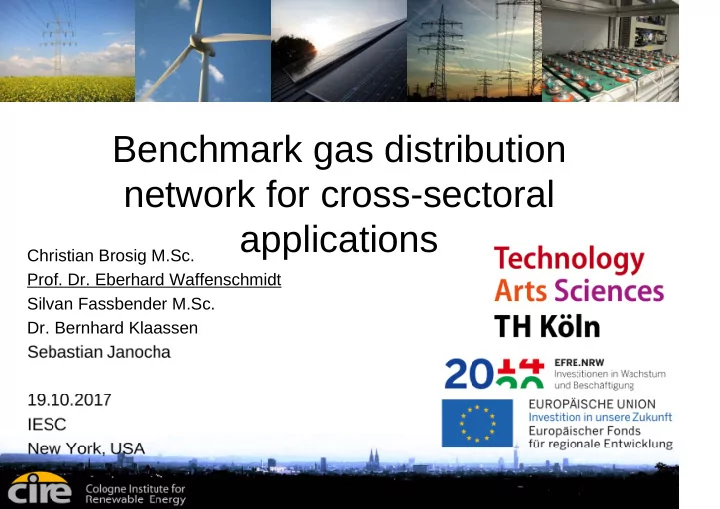

Benchmark gas distribution network for cross-sectoral applications Christian Brosig M.Sc. Prof. Dr. Eberhard Waffenschmidt Silvan Fassbender M.Sc. Dr. Bernhard Klaassen
ES-FLEX-INFRA [1]
Benchmark systems ✔ General validity for investigations ✔ Comparable and verifiable results ✔ Anonymous, synthesized data for easier publishing ✔ Simple network structures for easy verification and clear overview 3
distributed energy resources ● Connections to the gas network: – CHPs – Fuel cells no gas benchmark network available yet [2] 4
Deriving a gas benchmark network ● Based on CIGRE MV network ● Synthesized from present RNG distribution network – Medium pressure: 3 meshed / 3 radial grids – Low pressure: 3 meshed / 3 radial grids – Parameters considered: ● Pipe diameters, materials, lengths ● Building structure/usage within topologies ● Longest pipe length from superordinate network 5
Assumptions and simplifications ● German low calorific gasmix [3] – Calorific value: 9.8 kWh/m³ – Wobbe-Index (WI): 12.4 kWh/m³ – Relative density: 0.626 ● 70 % of households with gas supply ● Simultaneity factor: 0.7 ● Households aggregated block-wise – 50 m pipe length to block of households 8
First simulation results ● Multiphysical Network Simulator [7] ● Includes models for: – All relevant network elements – gas laws – Gas composition, molar composition and temperature propagation over the network – Joule-Thomson effect 13
First simulation results ● Medium pressure ● Pressure drop: – 23 mbar ● G2P loads: → no problem. ● Low pressure: – 2 mbar drop 14
Conclusion ● Gas distribution benchmark network developed from: – CIGRE electricity benchmark system – RNG network data from Cologne area ● Pressure drops of 0.02 (LP) to 0.23 mbar (MP) in the network ● Additional loads in gas network → no problem ● Gas feed-in limited to coverage of demand 15
Outlook ● Analysis of interdependent impacts (power and gas network) ● District heating network benchmark ● Integral energy system benchmark 16
References [1] TH Köln. (2017, Aug. 25). Forschungsprojekt ES-FLEX-INFRA [Online]. Available: www.th-koeln.de/informations-medien-und-elektrotechnik/forschungsprojekt-es-flex- infra_37260.php [2] K. Strunz, et al., "Benchmark systems for network integration of renewable and distributed energy resources", CIGRE Task Force C6.04.02, 2013. [3] Gasbeschaffenheit , Deutscher Verein des Gas- und Wasserfaches e. V. (DVGW) worksheet G260:2013-03, 2013. [4] I. Stadler, M. Sterner, Energiespeicher – Bedarf, Technologien, Integration , Berlin Heidelberg: Springer, Germany, 2014. [5] J. Mischner, H.-G. Fasold, J. Heymer: gas2energy.net - Systemplanerische Grundlagen der Gasversorgung , 2 nd ed., Munich: DIV Deutscher Industrieverlag GmbH, Germany, 2015. [6] R. v. Basshuysen (ed.): Erdgas und erneuerbares Methan für den Fahrzeugantrieb , Wiesbaden: Springer Vieweg, Germany, 2015. [7] T. Clees, K. Cassirer, N. Hornung, B. Klaassen, et al., “MYNTS: Multi-phYsics NeTwork Simulator”, 6th International Conference on Simulation and Modeling Methodologies, Technologies and Applications, SIMULTECH 2016 , pp. 179-186, Lisbon, 2016. 18
Recommend
More recommend